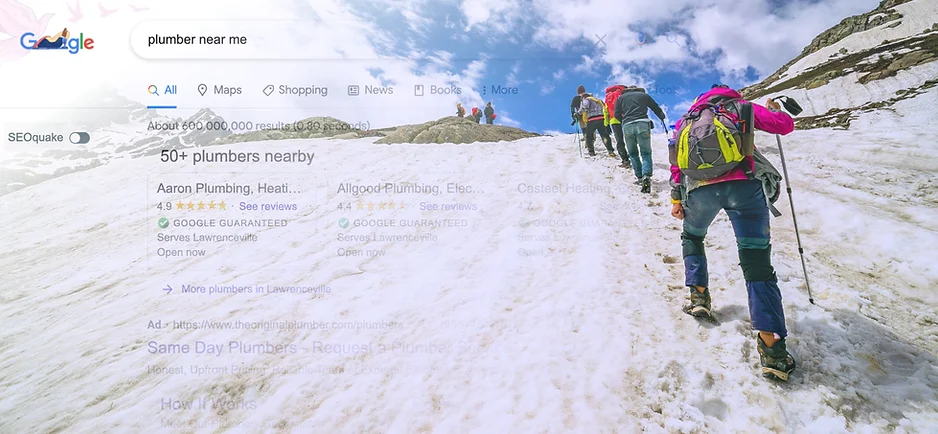
SEO Strategy is one of those topics that small business owners often talk about, but never seem to get around to understanding.
In this article, written to attract small business leads to an SEO agency, I introduce topic clustering to the average Joe. Using the metaphor of a mountain climbing expedition the reader is invited to consider making a sizable investment with a rich reward. If you’re curious, read the article in its entirety below.
I’m sitting here on a rare snowy day in Lawrenceville, Georgia thinking how rewarding it is when I get a new business lead through organic search. No fees paid to third-party services, God love ’em. No pay-per-click fees to Google, Bing, or Facebook. Just an honest-to-goodness organic search that finds me and clicks that Schedule a Call button.
Nine times out of ten that hard-working business owner is going to ask me this: “What do I need to do to get my website to the top of the search results?” Well, that’s exactly what we’re going to talk about right here, as soon as I let the dogs play in that white fluffy stuff outside.
Showing up at the top of search results consistently means you’ve convinced Google your website does a better job of answering people’s questions on the topic than the competition’s.
Sound like a lofty goal? It absolutely is – like climbing to the top of a snowy peak. But you can do it. You just need a guide and a plan.
What you cannot do in SEO, unfortunately, is hire a helicopter pilot to take you to the top. That’s called Paid Search (you know…Google Ads). To get to the top of organic search results you’ve got to climb – step by step.

The overall idea is that as you start to rank for some of the longer keywords that have less volume, your site authority will grow, giving you the ability to rank for more difficult keywords with larger search volume.

First let’s make sure we’re heading in the right direction. It wouldn’t do to get halfway up Mount Keyword only to see all your prospective customers atop Mount Different Keyword. That would suck.
So before you settle on a keyword, let’s do a little research to find the most popular keyword people use to look for businesses like yours.
If you’re a plumber that’s easy. That’s because there’s a fairly well-known list of services, and pretty much everyone knows that the person who performs those services is called a “Plumber.”
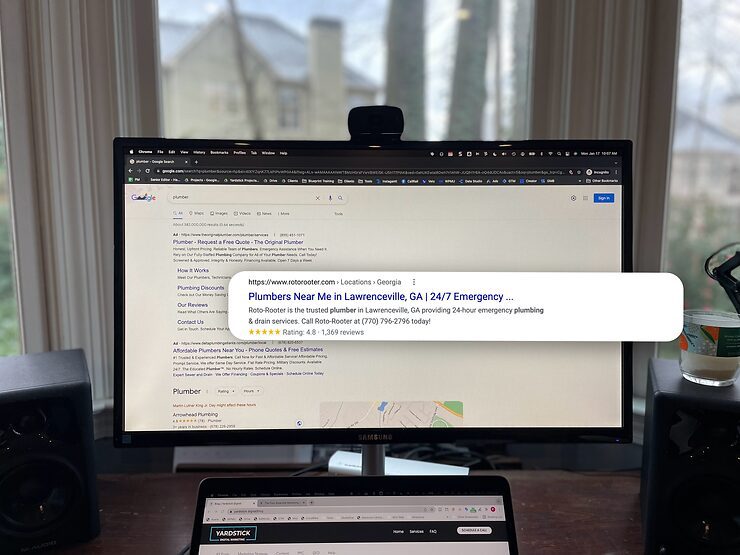
If, on the other hand, you to sell beautiful decorative books in bulk that interior designers use to stage hotels, restaurants, and such, it might not be so easy. But give it a try: how would you sum up the products you sell?
Once you’ve picked your main keyword, we need to validate them. To do this, we’ll use Ubersuggest.
Ubersuggest is a remarkable tool that gives you access to loads of information about how people are searching the Internet. And since it’s free to try, it’s a great solution for you to play along.
You don’t have to sign in (as of Feb. 2022). Just type your keyword in the long box at the top and click Search.
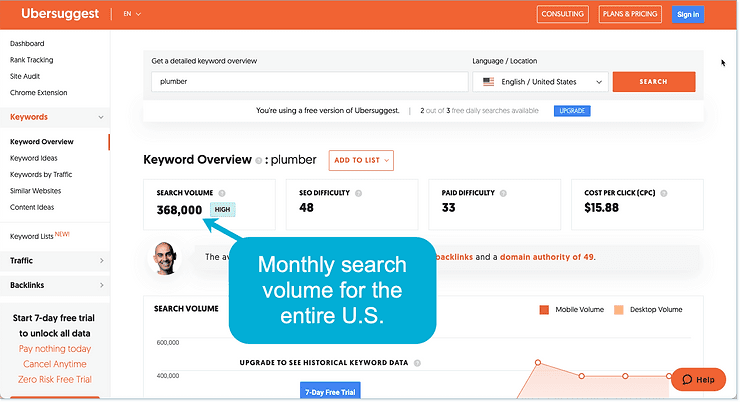
When we type in “plumber” we find out that around 368,000 people per month search for this keyword. And in case you weren’t sure, Ubersuggest tells us this is “High.”
So if you’re a plumber, you’ve got confirmation right away that you’ll be optimizing your home page to get in front of a lot of searchers.
But before you close the window, there’s one more key piece of info you need to make note of: SEO Difficulty. The SEO Difficulty score tells us how hard it will be to get your page to show up in organic search results.
A difficulty score of 48 is daunting for a new website. It’s not likely that we will show up in searches very far from our location. But this is our home page and that keyword best describes what we do, so we’re not going to sweat it yet.
For now let’s satisfy ourselves that the keyword we’ve chosen for our home page has a large audience.
If one of your web pages shows up consistently in search results, we say it’s “ranking” for the keyword that was searched. The term “rank” suggests you hold a position among your competition, and that’s true, but Google doesn’t give you a number – it’s way too complicated. But fortunately that hasn’t kept people from trying.
There are a number of SEO tools out there that analyze the data Google makes available in order to compute how your web pages rank for certain keywords. Each tool has its own methods so don’t expect them to agree. Pick a tool and stick with it, because what you’re really looking for is change in rank over time.
While we’re agreeing on terminology, let’s also agree on this: Each page on your website needs to have one primary keyword that it is targeting.
While it may end up ranking for multiple keywords, each page needs to clearly signal to Google the one main thing your page is about.
The reverse is also true: Only one page on your website should target each keyword. Taking steps to get a second page to rank will just bewilder Google. We call that cannibalization, and most of us agree that cannibalization is not good.
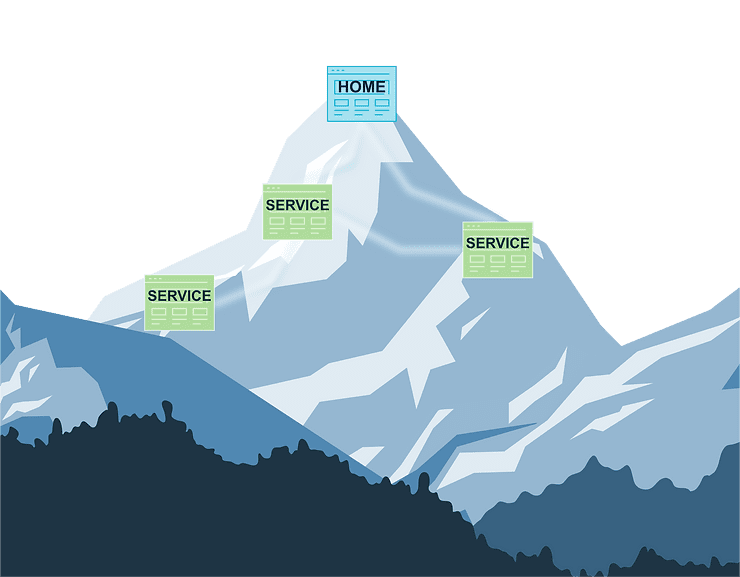
Each page needs to be optimized for the best keyword fit. Of course, choose a keyword that has high volume if you can, but most importantly, choose a keyword that accurately reflects what’s on the page – what you sell or do.
This may be a good time to check out the competition. What do they call the services they offer?
These second-level pages not only help people understand what you provide and why they should value it, they help signal the structure of your website to Google. They provide context for the rest of your content.
So pull out your spreadsheet and list out your services and product categories. Remember to drop each keyword into Ubersuggest to check search volume. But this time, go one step further and scroll down the page and check the Keyword Ideas to see if there is a better fit.
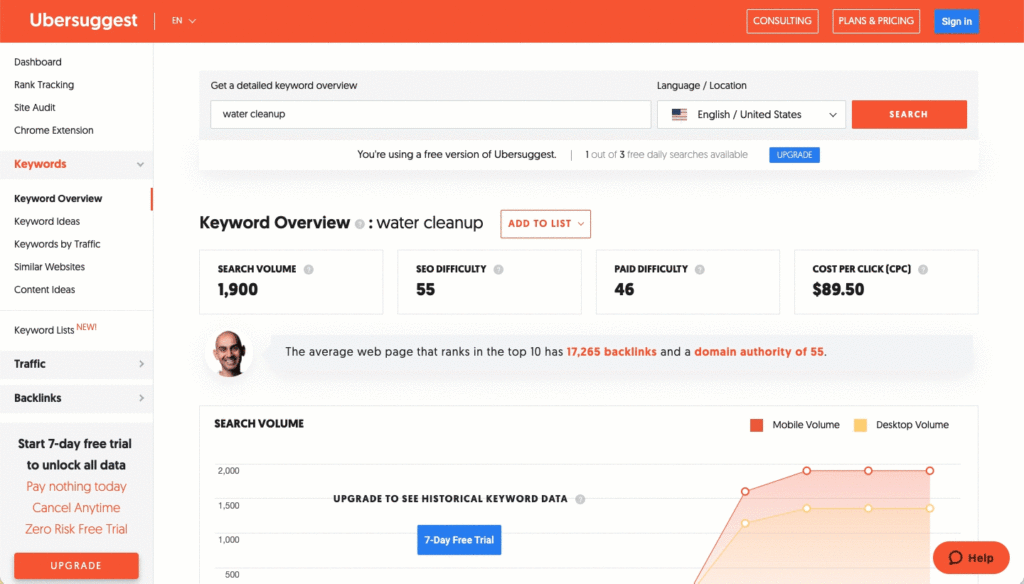
When your friends boast about their recent climbing expedition they probably lead with the goal they achieved, not the steps they took to get there. They’ll nonchalantly rattle off “…yeah, we climbed Mount Aconcagua,” as if you knew where that was. And you’ll be impressed, because you assume it’s big, and that they made it to the summit.
My point is that they don’t lead with “on the first day we packed all our gear and made it to the Horcones base camp.”
But we all know that to hike to the top of a mountain you have to make it to a number of tricky, lesser-known destinations on the way.
Those are your long-tail keywords. “Long tail” because there are lots of them, but they have lower search volume. Lower search volume means they are easier to rank for. The more of those long-tail keywords you rank for, the more likely you are to appear in search results for the keywords that make you money.
If your site is struggling against the competition, you are more likely to grow your traffic through lots of long tail keywords with low search volume than with those prized high-volume keywords.
But if you just start blogging about every keyword you find, you’ll end up with a mess. So let’s make a plan.
To maximize how each article builds upon the success of another, we’ll apply a structure known as “spoke and wheel” or “pillar and cluster.” The idea is simple: a general article on a particular topic (the Pillar) is surrounded by a number of articles on related subtopics (the Cluster).

For instance, a Physical Therapy office might have a Pillar page called Patient Conditions, with subpages on lower back pain, knee pain, and shoulder pain. Another Pillar page might be about Worker’s Comp, with subpages on capacity evaluations, job demands analysis, and onsite therapy.
Each of these pillars represents an area of knowledge that you’ve worked hard as a business to master. And it represents a group of questions people are asking who want to do business with you.
So if the process ahead gets a little tedious, just tell yourself:
Just pick one and recite it over and over while you keep sharing your wealth of knowledge.
Creating great content around your area of expertise builds trust, moves people along in the sales process, and attracts more qualified buyers.
Before we start writing, let’s build out a list of topics. They’ll come from two sources:
We’ll end up with a marriage of the two that has both structure and relevance.
Think about the following to prompt you with “things you want to say.”
Each time you write down a topic, try to let it lead you to another topic. If you start to go down a rabbit hole in a certain area, just make a note that these are “topics about whatever” and move on. You don’t have to be exhaustive, just methodical.
Next, we’ll let Google help us find questions people are asking about our topics. To do so, we’ll use the “People also ask” feature of Google Search.
People sometimes need help putting videos in their blog posts on Wix, so I’ll search for “wix blog video” and then scroll down the results until I see People also ask.
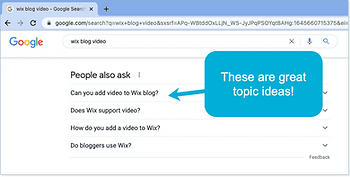
Repeat that with each of your topic ideas (and possibly your services or products as well), and you’ll find some gems to write about. In the process, you’ll also start to see commonalities between the topics that may help you organize.
By the way, if you like this Google feature, you should try out Answer The Public, which is far more robust.
Once you have your master list of topics to write about, it’s time to apply some organization to it. Remember, the idea is to cluster smaller topics together by category. Hands down, the best method is a card sort.
It’s fairly simple – write all the topics out on 3×5 cards and then sort them into piles of like topics – but why not watch a quick video from a pro.
Once you’ve sorted the topics, you’ll need to decide on Pillar names that encompass all of the topics in each group. Compile these into a spreadsheet, grouped by column, with the Pillar topic in the first row of each column.
We won’t go into how to write your content in this post, but let’s do take a minute to discuss the approach.
A pillar page covers in general the topics of its cluster pages, so many people prefer to start by writing the cluster pages. If you’ve already written the more detailed pages, creating the pillar is simply a matter of summarizing each cluster, adding an intro and conclusion, and creating internal links between.
Remember, one tactic we’ll be using is to build website authority by ranking first for keywords with lower difficulty scores.
We learned how to use Ubersuggest earlier to get the KD of each keyword, but if you think you might be doing this kind of research frequently, you might want to check out a tool like AHREFs or SEMRush, which allow you to look up multiple keywords at once and export the data.
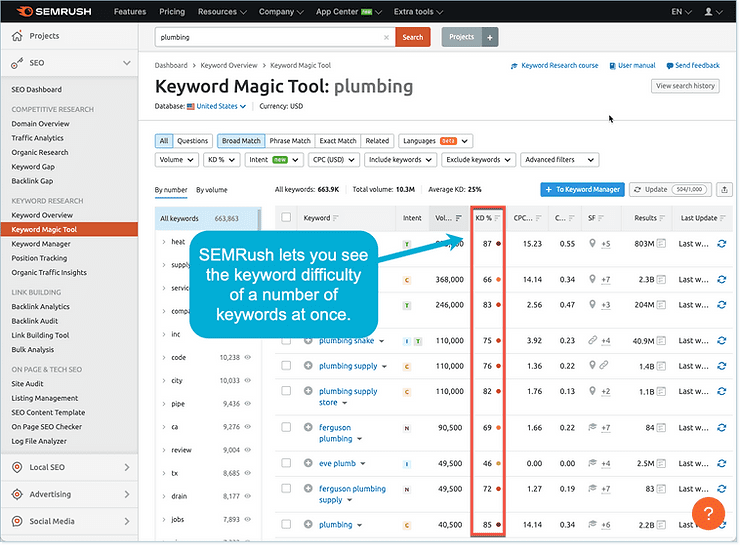
We’re not looking for a precise order here – just outliers. If you see that one pillar has significantly more difficult keywords, save it for later and start with an easier group.
Complete the pillars and clusters one at a time, remembering to interlink, until you find you’ve run out of topics.
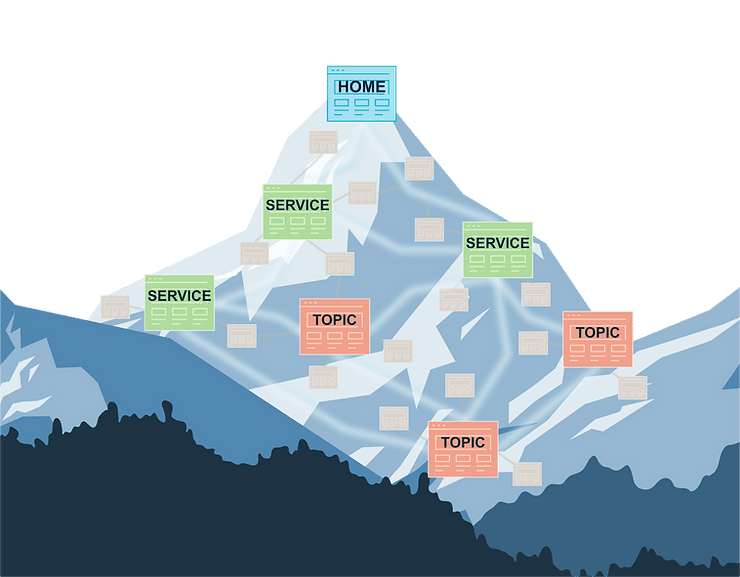
After reading through the steps I’ve outlined here you may be thinking “I’m not so sure I want to go through all of that.” I would imagine many people take a look at the mountain in front of them and decide they’d rather watch someone else climb it on TV.
But the reward is worth the effort, and as you implement the steps I’ve laid out here, you’ll begin to see your domain authority grow, your more difficult keywords start to generate organic traffic, and your brand to take its place among the winners at the top.
Good journey!
philwhite@mac.com
(770) 559-1823
1478 Napier Terr
Lawrenceville, GA
This website uses cookies to provide you with the best browsing experience.